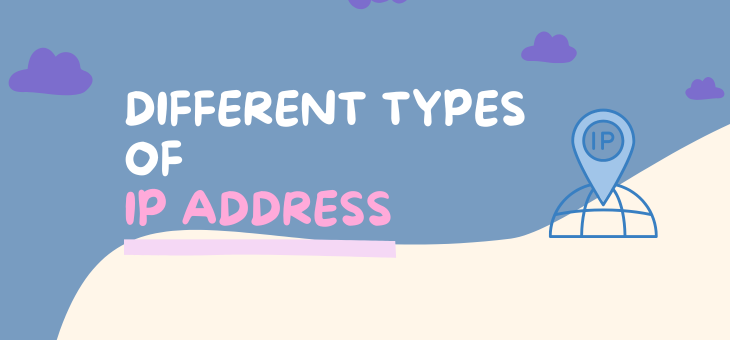
An IP address is necessary for all web-accessible devices, including servers, laptops, smartphones, and smart TVs, to transmit and receive data. There are different kinds of IP addresses that can be assigned to your device based on time, purpose, and location.
In this article, we have explained different types of IP addresses and their uses in computer networking. Furthermore, if you are interested, you can check out our fundamental networking courses to learn more about IP addresses.
What is an IP Address?
Internet Protocol, or IP, is a standardized set of rules that governs how data is transmitted and routed across interconnected networks such as the Internet. An IP address is a unique numerical label assigned to each device within a network, allowing it to communicate effectively with other systems.
There are two versions of IP addresses at the current time- IPv4 and IPv6.
IPv4
Internet Protocol Version 4 or IPv4 addresses are the standard IP addresses that are used in most devices. It uses a 32-bit format, typically displayed as four decimal numbers separated by dots, such as 192.168.1.1. IPv4 can uniquely identify around 3.7 billion devices, and the limit is exhausted. Network Engineers use subnetting to increase the range, but now more and more companies are switching to IPv6 addresses.
IPv6
Internet Protocol Version 6, or IPv6, is a successor to IPv4. It uses a 128-bit format, written in hexadecimal and separated by colons, for example, 2001:db8::1. Built to tackle the problem of exhausting IP address space of IPv4, IPv6 provides around 340 undecillion unique IP addresses, meaning IPv6 has approximately 79 octillion (7.9 × 1028)

How are IP Addresses Assigned?
Most networks assign IP addresses using DHCP, which automates the process and reduces manual configuration. IPs can be assigned dynamically, where devices receive temporary addresses that may change, or statically, where a fixed IP is manually set for a device.
DHCP servers manage address pools, lease durations, and prevent conflicts. In larger networks, administrators may reserve specific IPs for critical devices. For public internet access, ISPs assign IPseither static or dynamic, based on user plans. IPv6 simplifies this with auto-configuration and a vast address space.
Learn more about Dynamic Host Configuration Protocol (DHCP)
Types of IP Address
There are different categories of IP address, with each category containing different IP address and types.
Types of IP Address Based on Scope
Based on how an IP address is assigned, there are two types of IP addresses:
1. Public IP Address
Public IPs are assigned by ISPs and are globally unique, allowing devices to connect over the internet. Also known as external addresses, public IPs are essential for hosting websites and online services.
● Used in: Web servers, routers, cloud services
● Benefits: Enables global communication
● Drawbacks: Limited availability, more exposed to cyber threats
2. Private IP Address
Private IPs are used within internal networks like home, office, etc, and are not accessible from the internet. They help conserve public IPs and are ideal for communication between devices in homes, offices, or data centers. These private addresses are not routable on the public internet and are generated by your router to keep your local network organized.
● Used in: LANs, Wi-Fi networks
● Benefits: Free, secure, conserves public IPs
● Drawbacks: Not accessible from the internet without NAT
Types of IP Addresses Based on Assignment
Depending on how IP addresses are assigned to a device, there are two types of IP addresses: Static and Dynamic IP addresses.
3. Static IP Address:
A static IP address is manually configured and remains unchanged over time. It provides a consistent identifier for a device on a network, making it easier to locate and connect to remotely. It’s essential for services like web hosting, VPNs, and remote access, where consistent connectivity is required.
● Used in: Hosting, VPNs, remote access
● Benefits: Reliable, easy to locate
● Drawbacks: Requires manual setup, may incur extra cost
4. Dynamic IP Address
A dynamic IP address is automatically assigned by DHCP servers whenever a device connects to a network. These addresses are temporary and can change over time, depending on the network configuration and lease duration. Dynamic IP address assignment simplifies network management by eliminating the need for manual IP assignment and is commonly used in residential and mobile internet connections.
● Used in: Home networks, mobile devices
● Benefits: Easy to manage, efficient IP usage
● Drawbacks: IP changes can disrupt services
Classification of IP Addresses by Operational Traits
Depending on how an IP address communicates in a network, the IP addresses can be classified into 4 categories: Unicast, Multicast, Broadcast, and Anycast.
1. Unicast
Unicast addressing refers to one-to-one communication. Unicast IP addresses can share data between a single source device to a single destination device. It is the most common method of communication on the Internet, used for everyday activities such as web browsing, file transfers, and email.
Example: A user accessing a website sends a request to the server's unicast IP address, and the server responds directly to that user.
2. Broadcast
Broadcast IP address does one-to-all communication within a local network. It transfers a data packet from one device and delivers it to all devices on the same subnet. Every device on the network can receive and process the broadcast message.
Example: When a computer tries to discover other devices in a LAN, it sends a broadcast message.
Note: Broadcast communication is only supported in IPv4. IPv6 does not support broadcasting and uses multicast or anycast instead.
3. Multicast
Multicast IP address also does one-to-many communication, but these IP addresses can send data from one source to multiple selected recipients who are part of a specific multicast group. It is more efficient than broadcast because it avoids sending data to devices that do not need it.
Example: Live streaming of a webinar or real-time stock updates to subscribed users.
Read our article on Difference between Broadcast and Multicast
4. Anycast
Anycast is a one-to-nearest communication model. A single IP address is assigned to multiple servers, and data sent to that address is routed to the server that is geographically or topologically closest to the requester. This method is widely used to improve network performance and reliability.
Example: Content Delivery Networks (CDNs) use Anycast to route user requests to the nearest server, reducing latency and speeding up content delivery.
How to Find Your IP Address and Its Type
| Device/Platform | How to Find IP Address | How to Identify Type |
|---|---|---|
| Windows PC | Open Command Prompt → Type ipconfig | Local IP shown under "IPv4 Address"; check router or ISP portal for public IP |
| Mac | Go to System Preferences → Network → Select connection → View IP | Local IP shown; use whatismyip.com for public IP |
| Smartphone (Android/iOS) | Settings → Wi-Fi → Tap connected network → View IP address | Usually private IP; use browser to visit whatismyip.com |
| Router Admin Panel | Log in to router via browser (e.g., 192.168.0.1) → Status/Internet tab | Shows both private (LAN) and public (WAN) IPs |
| Online Tools | Visit whatismyip.com or ipinfo.io | Shows public IP, ISP, location, and whether it's static or dynamic |
| Linux | Open Terminal → Type ip a or hostname -I | Shows local IP; use curl ifconfig.me for public IP |
How to Secure and Conceal Your IP Address?
Your IP address can reveal your approximate location and browsing habits. To protect your privacy and IP address, consider using the following techniques:
1. VPN Services
A Virtual Private Network (VPN) is a popular way to hide your IP address and secure your internet activity. It routes your traffic through a private server, encrypting both outgoing and incoming data to protect your identity.
2. Anonymous Web Browsers
Anonymous browsers like Tor go beyond incognito mode by encrypting your internet traffic and routing it through multiple servers worldwide. This process hides both your browsing history and IP address, offering strong privacy protection. Unlike incognito mode, which only prevents local tracking, Tor ensures anonymity across the web.
3. Proxy Servers
Proxy servers act as intermediaries between your device and the internet, masking your IP by making it appear as if traffic originates from the proxy. Unlike VPNs, proxies don’t encrypt data, making them less secure. Free proxies are often slow and unreliable, with some risk of compromising your privacy.
Summary
Understanding the different types of IP addresses is essential for managing network connectivity, security, and online privacy. Whether it's distinguishing between public and private IPs, static and dynamic assignments, or recognizing how data is transmitted through unicast, multicast, or broadcast methods, each type plays a unique role in how devices communicate.
As internet technologies evolve, especially with the rise of IPv6, knowing these classifications helps users and professionals make informed decisions about their digital infrastructure.
Gautam Kumar is a senior network engineer having more than 7 years of experience in different companies in India. His work experience in network support and operation and maintaining of any network makes him one of the most valuable IT professional in industry. He has been involving in planning, supporting the physical and wireless networks, ...
More... | Author`s Bog | Book a MeetingFAQ
Comments (0)
Popular posts


What are the Different Types of Network ...
10 Dec 2025
CCNA Exam Fees and Expenses Breakdown
25 Aug 2025
New Cisco CCNA Syllabus for 2025
3 Dec 2025
What is a Cloud Service Provider and Top ...
8 Dec 2025Recent posts

What is Default Gateway and What Does it ...
16 Dec 2025
What is a Hub in Computer Networks and ...
15 Dec 2025
What is Tree Topology in Networking?
15 Dec 2025
What is the Difference Between IPv4 and ...
15 Dec 2025
What is Application Security in ...
15 Dec 2025Upcoming batches
Contact learning advisor










